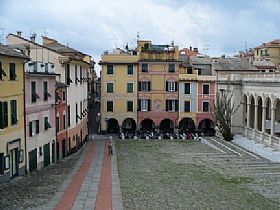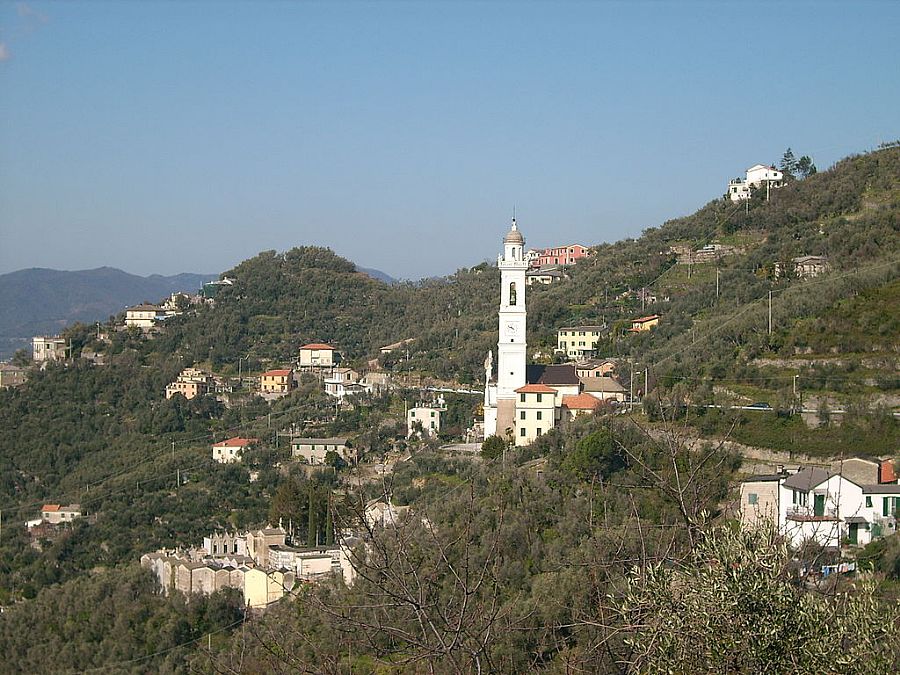Chiavari

On the Italian Riviera, Chiavari is a lively city of about 28,000 people that has a lot to offer. It's big enough to have an abundance of life, but small enough to be enjoyable. Sitting on the Entella River where it empties into the sea, it has a fertile river plain that is surrounded by mountains until it reaches the Mediterranean.
The historic center is sprinkled with Genovese style palazzi, Renaissance buildings, fountains and gardens. Elegant arcades flank some of the edifices. The pastel-painted town looks sunny and festive next to the dazzling water. It still enjoys an active fishing trade, along with crafts like lace-making, silk manufacture, and slate work. Abundant olive groves and flower growers provide cash crops for the area. The seafront is lined with swaying pine trees and a nice promenade.
Chiavari was founded as a Roman camp along the Via Aurelia, but there were 7th century BC necropoli found nearby, testifying of an earlier presence in the area. The charming streets of the historic center date from the Middle Ages.
The church of La Nostra Signora dell'Orto (Our Lady of the Garden) is a temple-like building with classical columns and pediment resembling the portico of the Pantheon. It was built to commemorate the apparition of the Madonna in what was then a vegetable patch in the 1600s. The church and its dome are richly decorated with frescoes. The pretty pastel church of San Francesco is done up in Baroque style with a lantern-like dome. The Palazzo di Giustizia, still the site of the city's courthouse, is built in heavy, exactingly-detailed Medieval style though it was actually constructed in 1886.
The Piazza delle Carrozze ("square of the carriages") has a green park in the middle and is a gathering spot, flanked by cafes and wedged in between the shopping streets of Chiavari. The Palazzo Rocca, just off the piazza, was built in the early 1600s as a noble residence. It is surrounded the Rocca Park and houses an important art gallery. The church of San Salvatore was built in 1124 but redone in 1613. It is officially known as the Basilica of San Salvatore dei Fieschi, for the noble Genovese family that commissioned it to be built in the neighboring village of Cogorno (which is administratively part of Chiavari). The monumental Romanesque structure has an enormous rose window and a beautiful bell tower attached.
Chiavari is a vibrant place, with an active civic life and a beautiful setting. Seaside sports and activities are available, but so are mountain treks and drives through the olive-studded hills, where gorgeous views of the sea can be had. Chiavari is only twenty minutes south of Genova, an important port city full of history and sights. Popular Portofino sits just around the bay at the tip of the gulf, still frequented by glitterati. There are two regional nature parks within minutes of Chiavari.
Have a look at our holiday homes in Chiavari.

 Amalfi Coast
Amalfi Coast Sorrento Coast
Sorrento Coast Tuscany
Tuscany Cilento National Park
Cilento National Park Lake Como
Lake Como Rome and Latium
Rome and Latium Umbria
Umbria Capri and Ischia
Capri and Ischia Venice
Venice Puglia (Apulia)
Puglia (Apulia) Liguria
Liguria Sicily
Sicily Lake Maggiore
Lake Maggiore Lombardy
Lombardy Sardinia
Sardinia Lake Garda
Lake Garda Abruzzo and Marche
Abruzzo and Marche Calabria
Calabria


Been there? Done that? Share your experience and tips!
Haven't visited yet? Have questions about Chiavari? Ask them here!